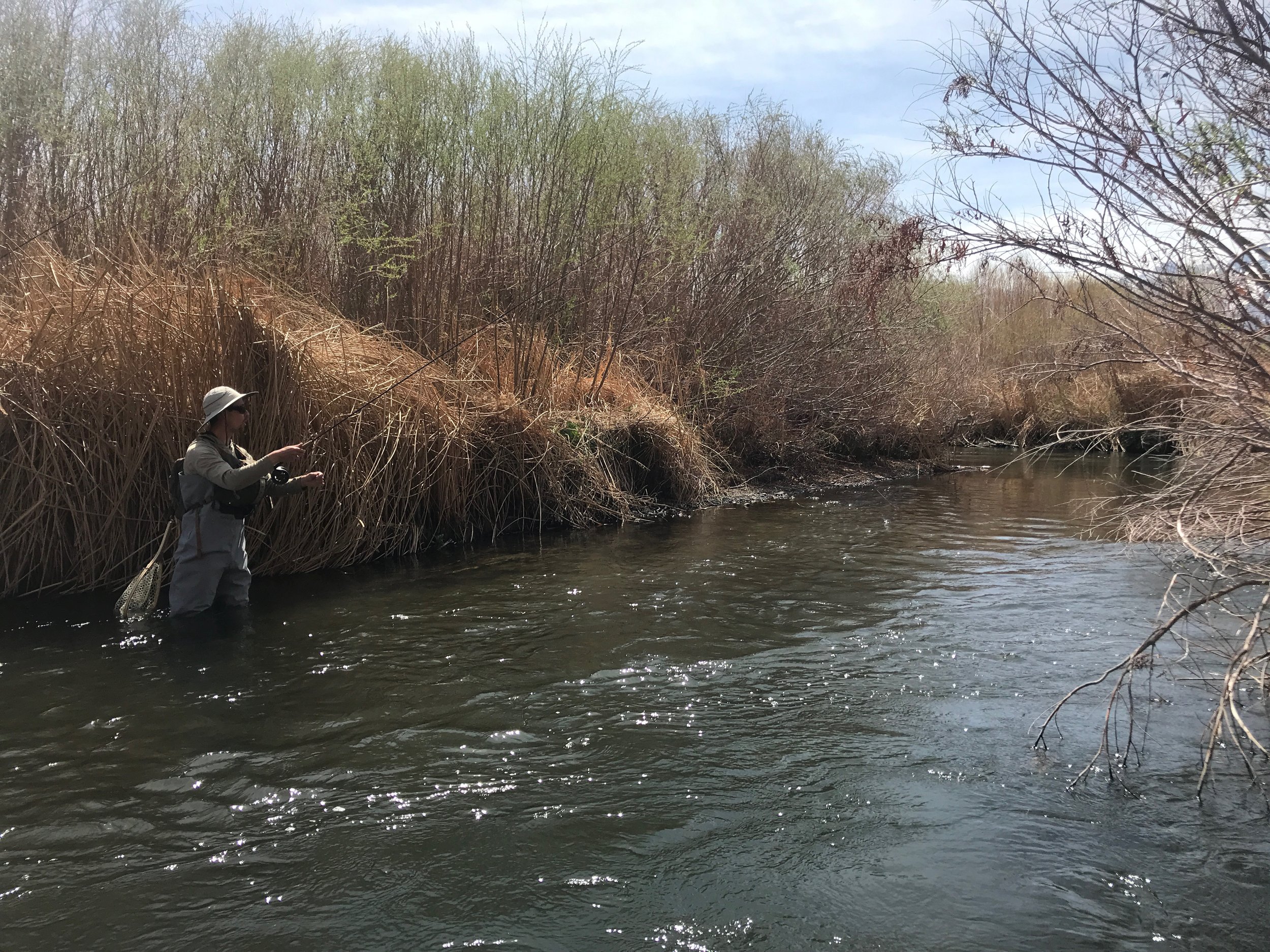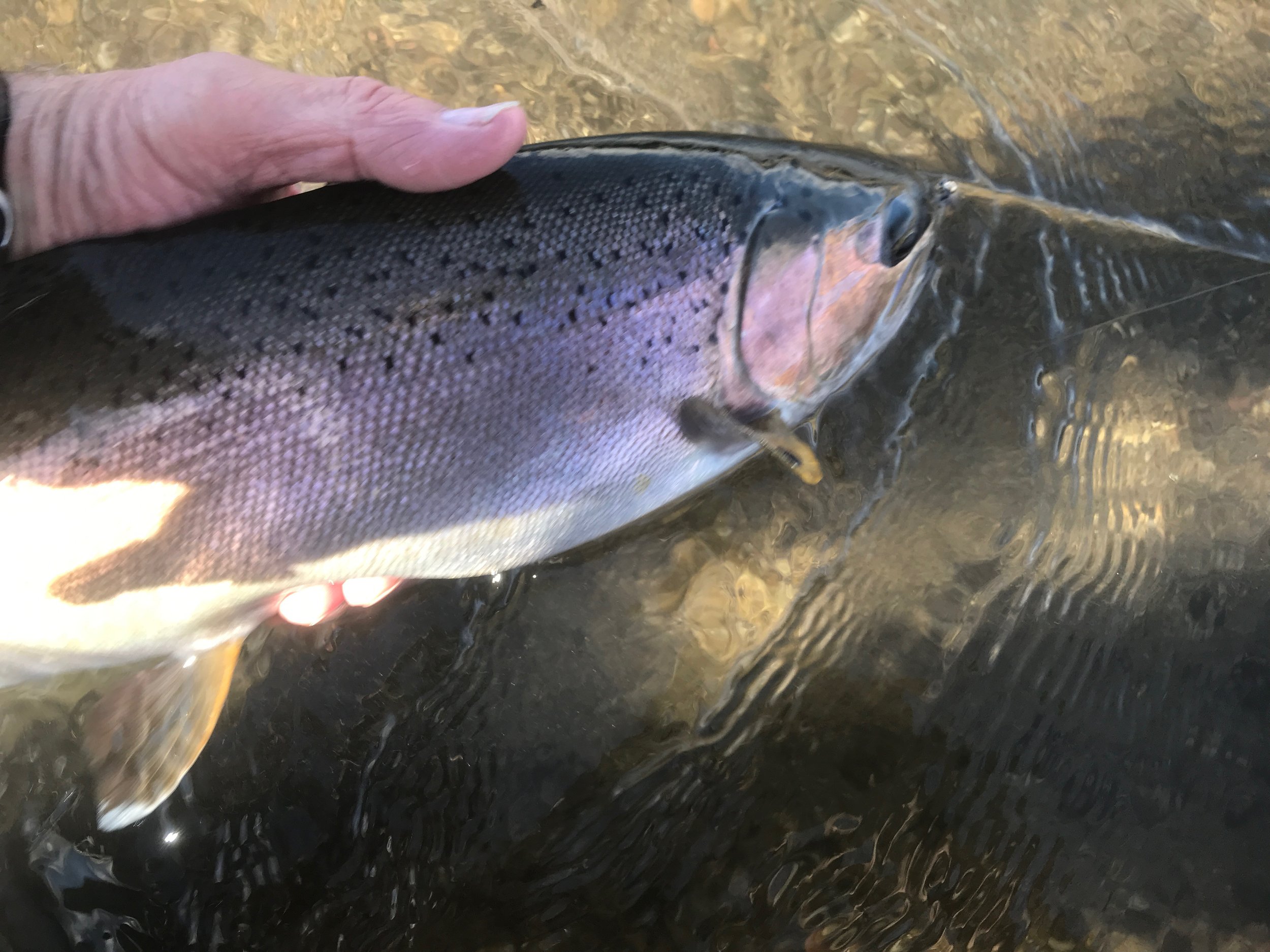Spring is here. Temperatures are in the high 70’s to low 80’s. I’ve had the air conditioning on in the truck as I drive to and from my fly fishing spots. Bass, carp, and bluegill are getting active in the Owens Valley. It’s time to start working the ponds, canals and Owens River for these fish. Mid-day continues to be when the insects are most active and the trout are responding by feeding on the nymphs and emerging mayflies, caddis flies, and midges. With most moving waters open to catch and release fishing with barbless flies and lures it time to start exploring some of the higher elevation creeks. This is an underutilized fly fishing opportunity in the Eastern Sierra in spring.
I know it’s spring when the dandelions take over my back yard and the insects and birds utilize them.
Lower Owens River:
Wild Trout Section:
Water is off color, but the trout are still feeding. Midge nymphs or pupae in zebra or tiger configuration, bead head flash back pheasant tail nymphs, olive quilldigons, and caddis emerger patterns are fooling the trout from morning to early evening. I’ve been fishing with a Euro rig pre blue wing olive hatch. The olive quilldigon has been responsible for most of my trout. The mid-day hatch of blue wing olives has been good enough to get my dry rod out of the case and bring it on the river with me. When the hatch starts, I go looking for a spot where all the trout are selectively feeding on the emerging blue wing olives. I’m fishing with a size 18 blue wing olive parachute or an olive sparkle dun. Caddis activity late in the day is worth throwing some elk hair caddis on the water.
Nate Ostrander from Bishop Euro nymphing a section of the lower Owens River that is only accessible by wading.
Hot Creek:
Interpretive Site:
With vehicle access to the creek fly fishing pressure has increased. Sometimes you need to get out before the hatches just to secure a spot on the creek. Mornings have seen good midge activity with the trout taking midge nymphs, pupae, and adults. For the nymphs and pupae I’m using size 18 to 22 tiger and zebra configurations. For the adults I’m using Griffiths gnats and biot midge emergers. An hour or two before the blue wing olive hatch I’m using a bead head flash back pheasant tail nymph. When the trout turn their attention to the hatching blue wing olives I switch to a dry fly and start using a blue wing olive parachute or an olive sparkle dun. I’m usually done with Hot Creek by 2:00 P.M. Then it’s time to go find lunch.
Hot Creek:
Canyon Section:
The canyon section offers better nymphing opportunities for fly fishers. I like to fish my flies under a fly and not an indicator. With the lower flows in the creek the commercial indicators spook to many trout. I’m using a size 16 Adams parachute with a midge nymph or pupae in tiger or zebra configuration. Mid-day before the blue wing olive hatch I put on a bead head flash back pheasant tail nymph in size 18. If the trout are feeding selectively on the newly hatching blue wing olive mayflies, I switch to a size 18 or 20 blue wing olive parachute. I fish with a dry and dry so that I can find my small dry fly on the water. I use the 16 Adams parachute for the dry in the dry and dry setup.
The winter run of rainbows from Crowley Lake are just about done for the year.
Upper Owens River:
Above Benton Crossing Bridge:
Fly fishers have complete access to the river on both sides with their vehicles. This has increased the fly fishing pressure in this area. The winter run of rainbows is slowly coming to an end. For the fly fisher willing to put in the effort of covering lots of water looking for the few pods of trophy trout that are in the system right now you will find a few trophy trout willing to take your fly. I’m still fishing with size 12 jigged stoner nymphs, green/gold Prince nymphs, and gold ribbed hare’s ears in the deeper pools, runs, and cutbanks.
Bob Creed from Riverside was able to catch several wild brown trout after rigging up an indicator nymph rig.
Bishop Creek Canal:
Behind the Ford Dealer:
Flows have increased in the canal and it’s easier to approach the trout. I’m fishing with a dry and dropper rig or under and indicator. I like to fish a bead head flash back pheasant tail nymph about 20 inches below the midge. I put a size one split shot between the two flies and the indicator 1.5 to 2 times the average depth of water above the bottom fly. I used this setup with Bob Creed from Riverside on Monday and he landed several wild brown trout. The canal will get better as water flows are increased.




